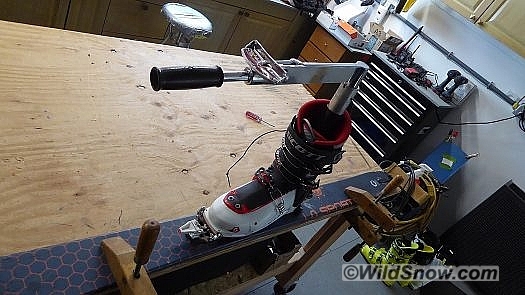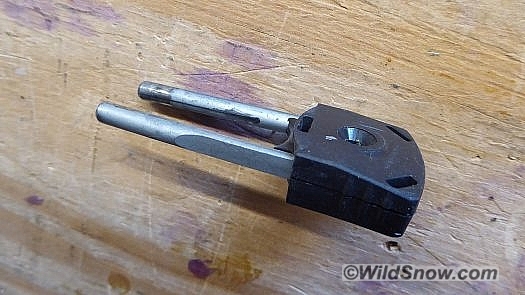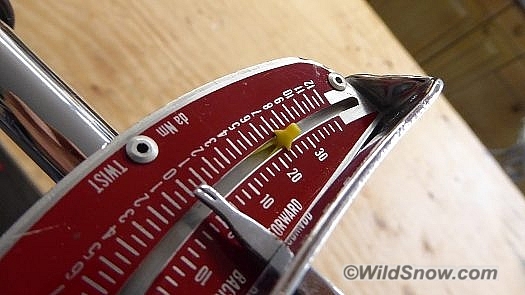We published this last spring. People missed it. Useful infos so we reup. The point of the exercise is you don’t want to be making assumptions about binding release and retention values. At the least, a hand check on workbench, better, actually measure. Exception being skiers who simply crank all settings to the maximum, as testing those rigs often requires excessive force, and they provide little to no injury protection needing verification. In other words, a binding set on release value 13 is about staying on your feet, not coming off.
And by the way… when you do your bench testing, be aware of gotchas such as the Fritschi Evo/Tecton offerings needing the boot toe actuation of binding toe opening during a forward release. Easy to check on the bench, major problem if this does’t function correctly.

‘Twist’ testing. (Binding shown is a Dynafit, while the binding we cover in this article is the Salomon-Atomic.
This project used a Vermont binding release checker. While this tool is designed for toe-wing (alpine) binding release checking of TUV certified DIN/ISO standard systems, it correlates well when used to evaluate lateral (twisting, side) release and retention of classic tech bindings. To verify, I checked a set of Dynafit Speed Radical I’ve got mounted up for my current Cosmos 3 boots, as well as testing with my quite used TLT-6 boots. Dynafit binding set on 8, checked out with release value (RV) of 7.5/8 on the torque wrench using my boot choices, other experiments showed good results as well. Thus knowing the Vermont instrument would give me usable results (at least for comparisons), I then played around with the Salomon-Atomic U-spring bindings.
Lateral, twisting, results (informal averages of several test cycles):
7 with the “Women” spring using Cosmos, and 6 with the TLT-6 (makes sense, see below for info about testing with no heel spring).
8 with the “Men” spring, Cosmos, 7 with TLT-6.
10 with the “Expert” spring using Cosmos, 9 with TLT-6.
(Vertical, forward release is challenging to measure accurately with the Vermont device due to the limited elasticity of tech bindings, but the numbers I got seemed fairly consistent with the TLT-6 lateral results. The “Expert” spring took so much force I was afraid of breaking the ski, so I didn’t get a measurement at that extreme, I’d imagine it’s at least 11.5. The “Men” spring measured 8.5 and the “Women” was 5.5. I only measured vertical force with the TLT boots, as rear Dynafit boot fittings are usually close matches across brands, and operate more simply than the toe system.)

“Women” spring has cutaway to reduce tension, interestingly it made little difference as opposed to releasing the boot with the heel unit disengaged, thus depending entirely on the toe unit.
Interestingly, when released with NO rear spring, I still got around RV 7 with the Cosmos and RV 6 with the Dynafit TLT-6, indicating how strong the Salomon-Atomic toe springs are in comparison to the weakest “Women” heel spring. More, and sadly, the toe fittings in my Cosmos test boots tended to catch during the release cycle and cause a spike. That’s an all too common problem you should always check for on the bench. A “sticky” boot is perhaps a non issue for skiers using higher RV settings (and might even be beneficial in terms of accidental release), but could be a factor if you’re seeking a smooth release at lower settings.
My testing indicates that no matter what, you won’t get a lateral release setting below about 6/7 for this binding (though that could vary depending on boot toe fitting action). Smaller folks take note. Since my testing indicates the various springs are actually providing a fairly limited range of values, there is no reason for more springs within the range. That explains why these bindings work well for so many people. In other words, if you’re seeking a an RV value setting in increments of around 1 or 2, you get that with the three available springs. On the other hand, an additional super-high value spring could be a good addition. Conversely, if you desire torsional release values below 6/7 a different spring won’t help, you instead need a different brand-model binding.
Huge caveat with all this is your boot fittings are part of the binding, and can significantly change your release values. Thus, as I’m always harping on, if you desire accurate settings it’s necessary to test each specific boot-binding setup. Otherwise your are engaging in guesswork or at best trial and error (i.e., set binding low, ski it, eject, dial up, repeat) Brakes are a factor as well, if you use brakes they may change your settings and the ski should be testing with the brakes, since this project is about comparing strength of springs and getting an approximation of release values, I did not test with brakes.
WildSnow.com publisher emeritus and founder Lou (Louis Dawson) has a 50+ years career in climbing, backcountry skiing and ski mountaineering. He was the first person in history to ski down all 54 Colorado 14,000-foot peaks, has authored numerous books about about backcountry skiing, and has skied from the summit of Denali in Alaska, North America’s highest mountain.

